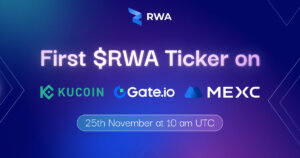 How to Put Crypto In Everyone’s Pocket in 2019
How to Put Crypto In Everyone’s Pocket in 2019 How to Put Crypto In Everyone’s Pocket in 2019

Cover art/illustration via CryptoSlate. Image includes combined content which may include AI-generated content.
In the same way all economic movements have done throughout history, blockchain finance challenges our traditional conceptions of ‘value,’ and, in turn, our ideas about identity and freedom. The new digital economy is now being built by a worldwide community who share common goals of decentralization, transparency, and financial inclusion.
My first real job was at Bank One Corporation in the Research and Recovery department, taking pictures of checks saved on spools of microfilm and mailing them out to customers. Flash forward a couple of decades, and technology has obviated and remade my old job many times over. Now I work in the latest iteration of that cycle—cryptocurrency.
Copying checks was my first peek behind the curtain of the global financial system, and it felt empowering. Cryptocurrency—and the fascinating blockchain technology behind it—has the potential to bring that feeling of empowerment to so many others. However, it is still perplexing to the average consumer with most not understanding why it even has value, let alone how to use and secure it. With over half the world’s population online, less than one percent is said to own or use cryptocurrency, signaling that mainstream adoption is not yet within reach.
As teams continue to build the tools and platforms that will redefine the global economy, there are four simple truths we should all keep in mind: keep it transparent, accessible, secure, and human.
Transparency Will Redefine Global Finance
When you break down the barriers to entry for both traditional and blockchain-powered finance, the barriers for the latter currently seem higher. But blockchain financial products only seem more complex, simply because we are witness to its inner mechanics, which is unfamiliar to most because of intricate code and cryptography.
Traditional finance hides similarly complex processes behind easy to use banking apps and ATMs. We can deposit money in a local branch with real people, an interaction that feels familiar and safe. But all of these interactions carry a far greater cost to our financial lives—monthly fees, transaction costs, crippling interest rates, contracts, passive data collection, and, most worryingly, financial exclusion and corruption.
The 2008 financial crisis nearly sank the global economy. However, after ten years, most people are still mystified by terms like “Credit Default Swap” and “Mortgage-Backed Securities” with no idea what role banks and bankers played in the collapse. Banks have barriers made of glass, with the curtains voluntarily drawn.
Blockchain’s transparency, however, enables individuals and businesses to see—in real time—what is happening with every single transaction, investment, fund, and credit, and exactly where they are stored and sent. This transparency, when combined with open source tools, not only has the potential for enhancing technological innovation, but also for elucidating the underlying economic principles of blockchain based financial products.
Maker is one of the most popular and well-respected platforms in the ecosystem precisely for these reasons. Want a loan but don’t understand what a Collateralized Debt Position is? The MakerDAO CDP portal provides a concise explanation. Follow the steps to generate Dai currency and fully understand your interest rate and the terms of repayment. There is no negotiation or contract to sign. A person should not need to be a banker to understand how their loans work, and that is one of the reasons why platforms like Maker are so compelling.
Make Crypto-Finance Easier Than Traditional Finance
One of the greatest barriers to the mass adoption of any groundbreaking new technology is its accessibility—both through its purchase cost and its usability.
But blockchain is not inherently free to run or to use. To be an active user of the blockchain is to pay for it in some way, like through transaction fees. But utilities themselves should be free, otherwise, we sustain a barrier to entry that is too high. Users need to be free to experiment—to learn by doing. As blockchain businesses, we can make our consumer tools free, making cryptocurrency more accessible. Builders of crypto platforms and tools can easily finance themselves through mechanisms such as transactions fees, micropayments, or B2B models.
The process of buying, storing, and transacting in crypto also demands a steep learning curve, so usability and user experience cannot be underestimated. The UX has to be simple and elegant enough to parallel how simple and elegant the blockchain really is, to interact with it, and observe its core functions.
Developing solutions that are intuitive to use and can be integrated with existing technologies, such as mobile phones, will help the world become crypto literate and, by extension, drive its widespread use. In the developed world, 82 percent of adults have both a mobile phone and access to the internet. In developing economies, the number is 40 percent. We can put cryptocurrency in their hands through mobile apps or customized crypto-finance mobile services that are simple to use.
From Security to Safety
The inherent security and immutability of blockchain technology are what makes it superior to traditional finance. But, as some critics have pointed out, what constitutes “security” is subjective. Ethereum Foundation researcher and Casper Protocol project lead, Vlad Zamfir, has said it’s Ethereum’s secure properties that can make it unsafe for users. Immutable and irreversible, blockchain transactions are perilous for naive crypto holders. It’s said that without significant hand-holding, onboarding new cryptocurrency users is “ethically dangerous.”
We need to be those hand-holders. As we develop our blockchain tools, built-in security should be a priority, helping to break the current stigma of the cryptocurrency industry as the ‘Wild West’ of finance.
As we’ve seen time and time again—nothing is unhackable, there are bugs in every system, and various forms of malfeasance cannot be avoided. Fraud is rising in cryptocurrency, and cybercrime evolves as fast as blockchain technology, playing to the biggest weakness of new users—their inexperience. While we must all commit to proactively educating our new users, our core responsibility lies in safeguarding them as the first line of defence.
We can integrate the best security measures proven to mitigate risk, providing as many layers of protection as necessary. This includes hardware functionality, two-factor authentication, MetaMask compatibility, and never requiring users to enter private keys into their browser.
At the end of the day, if we want the average person to move toward crypto-finance and store their rainy-day fund in a crypto wallet, those funds should be respected by offering the best possible security.
Technology Is Inherently Human
Beyond all of these design concepts, it is important to remind ourselves that a blockchain—as a global, decentralized network—is made up of real people. If it’s destined to survive and reshape our global economy, diverse populations should consider the blockchain a place where they belong.
For blockchain to have anything resembling that sentiment, it’s necessary to understand that every node run, every transaction sent, and every contract executed, has its roots in a fundamental human impulse. It means that someone out there is just trying to buy a home, raise a child, get a job, or just relax at the end of the day.
The different ways people are drawn to crypto and blockchain are continuously growing as new use cases tap into the imagination of those who see beyond technical aspects, or beyond the investment opportunities that enticed early adopters. Serving and incorporating diverse and marginalized voices in the creation of this ecosystem is essential to its longevity and broader adoption.
Some rules are not meant to be broken. As the global economy slowly turns digital, hopefully, the teams at the forefront driving this transformation will create new rules which help place cryptocurrency in everyone’s pocket, as well as break some old rules that no longer serve us all.



 Farside Investors
Farside Investors 


 CoinGlass
CoinGlass 































































































